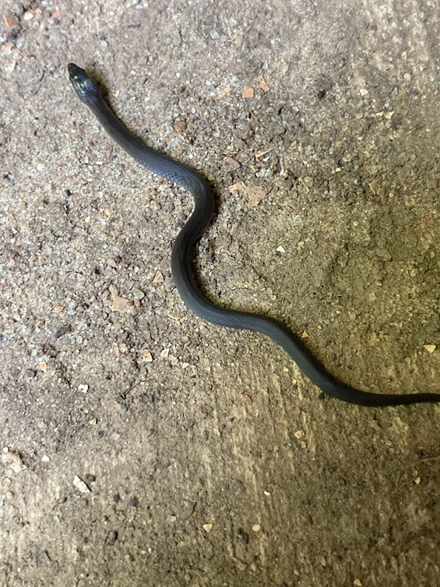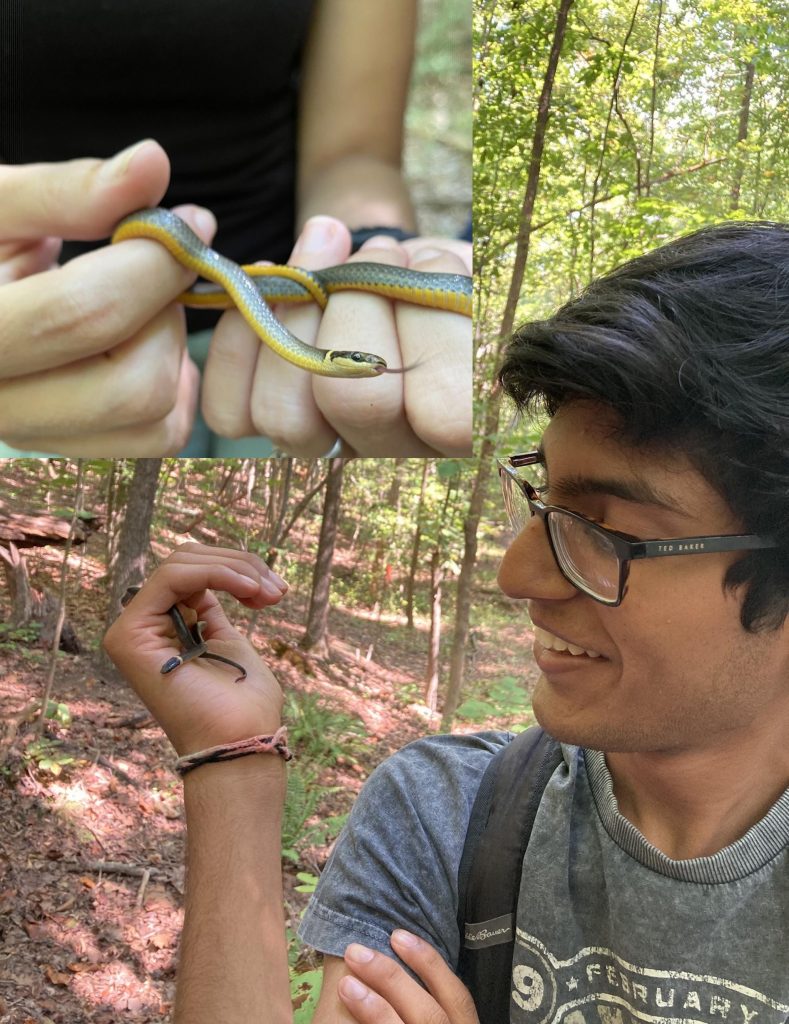
Upper left: Dr. Nicki Cagle holding a ring-necked snake. Photo by Montana Lee, another Wild Ones member.
On a sunny Friday in September, Dr. Nicki Cagle led a herpetology walk in the Duke Forest with the Wild Ones. The Wild Ones is an undergraduate club focused on increasing appreciation for the natural world through professor-led outings. Herpetology is the study of reptiles and amphibians.
Dr. Cagle is a senior lecturer in the Nicholas School of the Environment at Duke and the Associate Dean of Diversity, Equity, and Inclusion. Along with teaching courses on environmental education and natural history, she is also the science advisor for a citizen science project focused on reptiles and amphibians, or herpetofauna, in the Duke Forest. Volunteers monitor predetermined sites in the Duke Forest and collect data on the reptiles and amphibians they find.
“We get a sense of abundance, seasonality… and how the landscape is affecting what we’re seeing,” Dr. Cagle says. There is evidence that herp populations in the Duke Forest and elsewhere are decreasing.
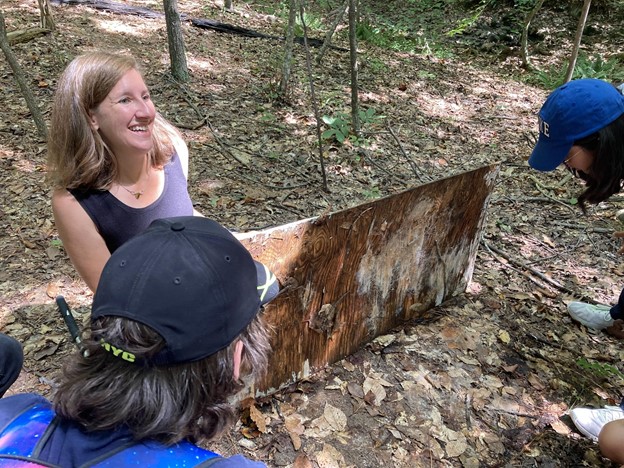
The project relies on transects, “a sampling design… where you have a sampling spot at various intervals” along a line of a predetermined length. In this case, the sampling spots are “traps” meant to attract reptiles and amphibians without harming them. Each site has a large board lying on the ground. “Different herps are more likely to be found under different objects,” Dr. Cagle explains, so the project uses both wooden and metal cover boards.
But why would snakes and other herps want to hide under cover boards, anyway? Reptiles and amphibians are “cold-blooded” animals, or ectotherms. They can’t regulate their own body temperature, so they have to rely on their environment for thermoregulation. Snakes might sun themselves on a rock on cold days, for instance, or hide under a conveniently placed wooden board to escape the heat.
Salamanders that use the cover boards might be attracted to the moist environment, while “snakes will tend to go under cover boards either to hide — like if they’re about to molt and they’re more vulnerable — to look for prey, or just to maintain the proper temperature,” Dr. Cagle says.
Citizen scientists typically check the boards once a week and not more than twice a week. Volunteers have to avoid checking the traps too often because of a phenomenon called “trap shyness,” where animals might start avoiding the traps because they’ve learned to associate them with pesky humans flipping the boards over and exposing their otherwise cozy resting places. By checking the traps less frequently, scientists can reduce the likelihood of that and minimize disturbance to the animals they’re studying.
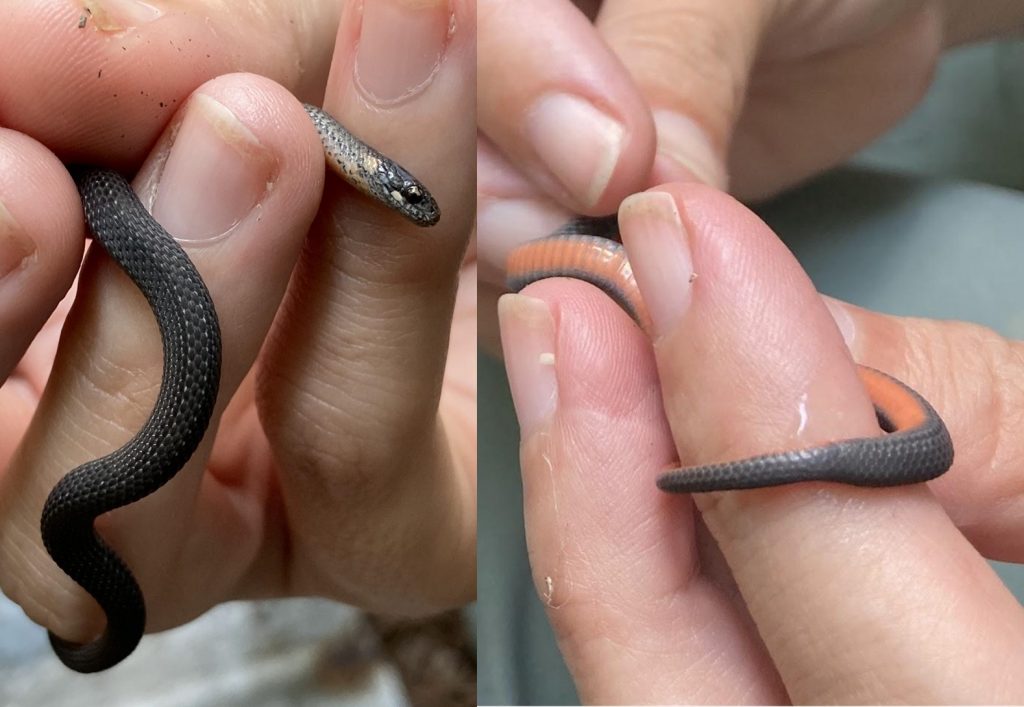
Dr. Cagle gave the Wild Ones a behind-the-scenes tour of some of the cover boards. Using a special, hooked tool conveniently stashed in a PVC pipe next to the first cover board, we flipped each board over and looked carefully underneath it for slithery movements. We didn’t find any under the first several cover boards.
But then, under a large sheet of metal, we saw a tiny snake squirming around in the leaf litter. There was a collective intake of breath and exclamations of “snake!”
Dr. Cagle captured it and held it carefully in her hands. Snakes, especially snakes as young as this one, can be all too easily crushed. We gathered around to look more closely at the baby snake, a species with the adorable name “worm snake.” It was dark above with a strikingly pink underside. The pink belly is a key field mark of worm snakes. Earth snakes are also found around here and look similar, but they tend to have tan bellies.
After a minute or two, the worm snake made a successful bid for freedom and wriggled back under the board, disappearing from sight almost immediately.

Some of the cover boards revealed other animals as well. We found a caterpillar chrysalis attached to one and several holes — probably made by small mammals — under another.
Whatever made the holes, we can safely assume it wasn’t a snake. According to Dr. Cagle, the term “snakehole” is misleading. Most snakes don’t make their own holes, though some of them do use existing holes made by other animals. One exception is the bull snake, which is known for digging.
We found a young five-lined skink sunning itself on top of one of the metal cover boards. (Thermoregulation!) Juvenile five-lined skinks are colloquially known as blue-tailed skinks, but the name is somewhat misleading — the adults don’t have blue tails at all.
The snakes we were looking for, meanwhile, were often elusive. Some vanished under the leaf litter before we could catch them. Sometimes it was hard to tell whether we were even looking at a snake at all.
“What are you?” Dr. Cagle muttered at one point, crouching down to get a better look at what was either a stick-esque snake or a snake-esque stick. “Are you an animal? Or are you just a wet something?” (Just a wet something, it turned out.)

Later on, we found at least three young ring-necked snakes (Diadophis punctatus) under different cover boards. One of them was particularly cooperative, so we passed it around the group. (“All snakes can bite,” Dr. Cagle reminded us, but “some have the tendency to bite less,” and this species “has the tendency not to bite.”) Its small, lithe body was surprisingly strong. The little snake wrapped tightly around one of my fingers and seemed content to chill there. A living, breathing, reptilian ring. That was definitely a highlight of my day.

If you’ve ever wondered if snakes have tails, the answer is yes. The official cut-off point, Dr. Cagle says, is the anal vent. Everything below that is tail. In between flipping over cover boards and admiring young snakes, we learned about other herps. Near the beginning of our walk, someone asked what the difference is between a newt and a salamander.
“A newt is a type of salamander,” Dr. Cagle says, “but newts have an unusual life cycle where they spend part of their life cycle on land… and that is called their eft phase.” As adults, they return to the water to breed.
We learned that copperheads “tend to be fatter-bodied for their length” and that spotted salamanders cross forest roads in large numbers on warm, rainy nights in early spring when they return to wetlands to breed.
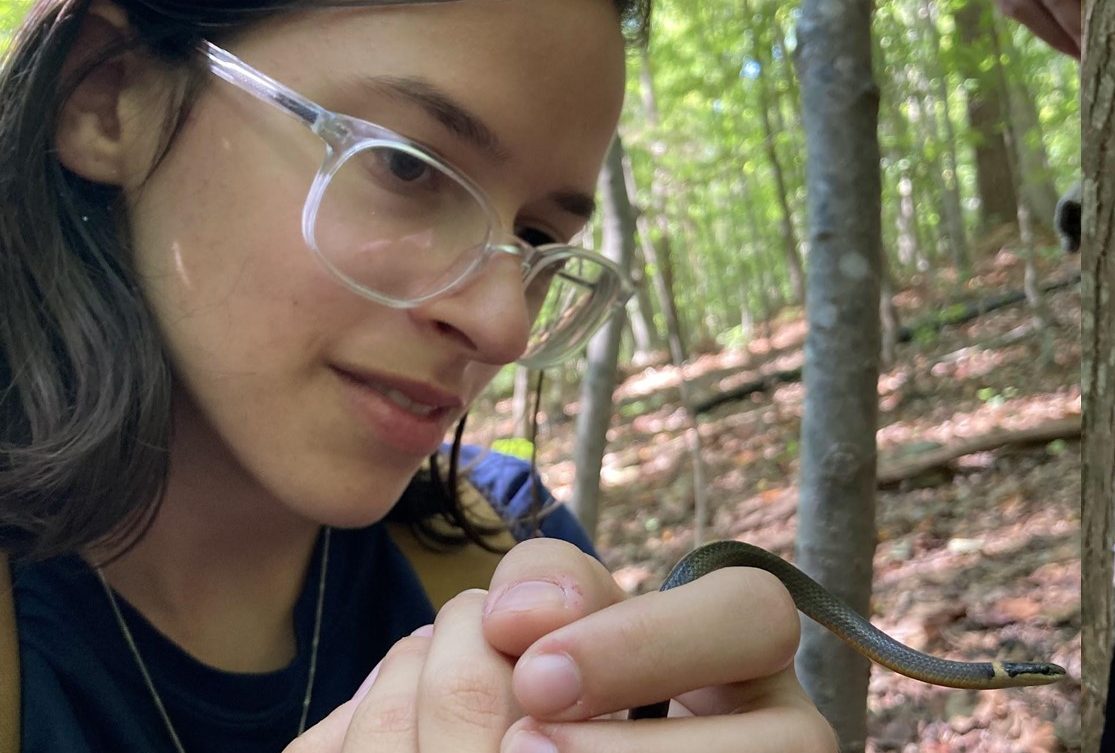
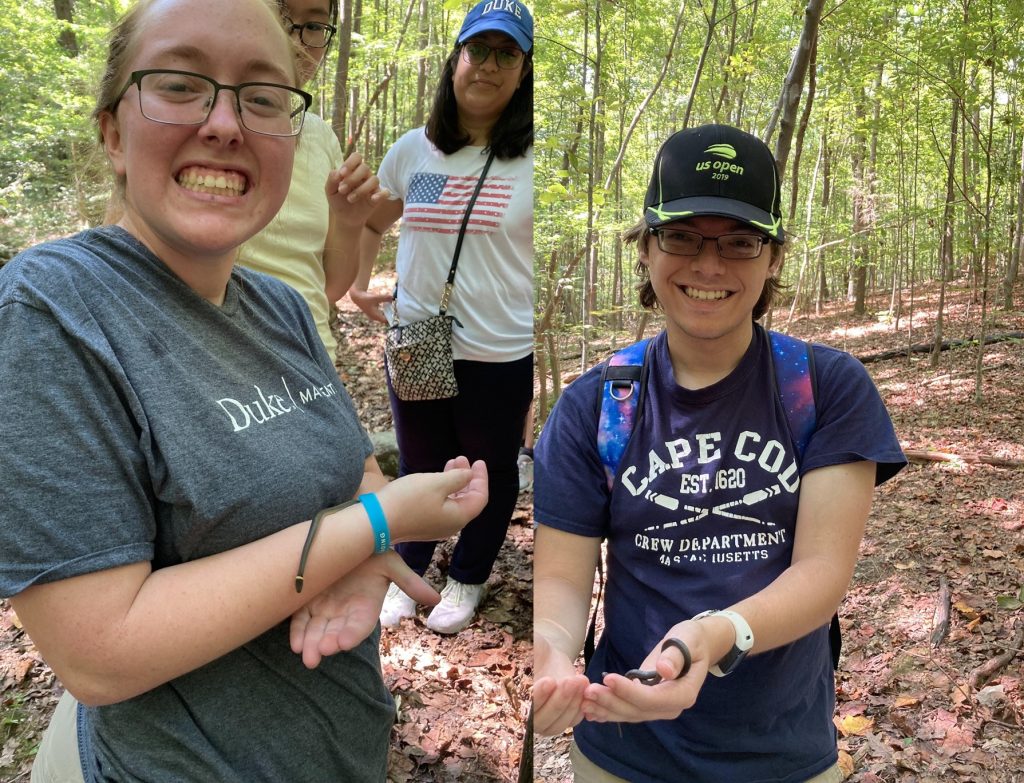
Perhaps the most interesting herp fact of the day came near the end of our walk when one of the students asked how you can tell the sex of a snake. Apparently there are two ways. You can measure a snake’s tail (males usually have longer tails), or you can insert a metal probe, blunted at the end, into a snake’s anal vent. Scientists can determine the sex of the snake by how deep the probe goes. It goes farther into the anal vent if the snake is a male. Why is that? Because male snakes have hemipenes — not two penises, exactly, but “an analogous structure that allows the probe to slide between the two and go farther” than it would in a female snake. The more you know…

Disclaimer: Handling wild snakes may result in snake bites. It can also be stressful to the snakes. Furthermore, some snakes in this area are venomous, and it’s probably best to familiarize yourself with those before getting close to snakes rather than afterward. Snakes are amazing, but please observe wildlife safely and responsibly.
